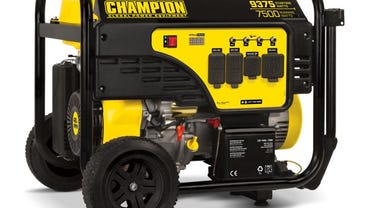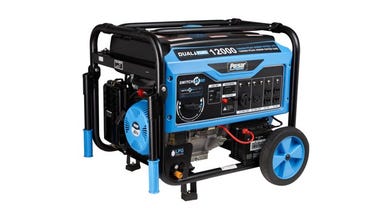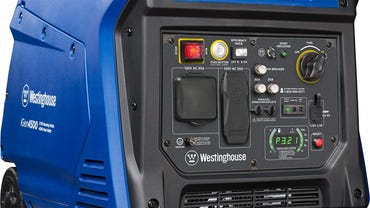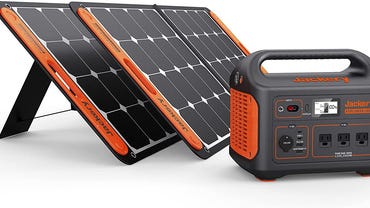Power outages from extreme weather is a year-round threat, but with a portable gas or battery-powered generator, you can keep essential medical equipment, appliances, and mobile devices running. When shopping for a portable generator, make sure you know how many watts you’ll need to run things like lights, phone chargers, and electric ranges and add around 10 percent to ensure that there will be enough energy to go around. And when you get your generator, remember to never use a gas or liquid propane-powered engine indoors and never plug a generator into your home’s electrical system without first installing a transfer switch to prevent fires and other electrical damage. I’ve combed the web to find the best deals on portable generators so you can save a little money while prepping for extreme weather situations.
Also: Best portable power station: Emergency power when you need it
Portable gas generator with electric start
Right now, Walmart is running a great markdown deal on this portable gas generator from Champion. It features an electric start so you don’t have to mess with a ripcord and Champion’s Cold Start Technology for consistent engine ignition even in cold weather. This generator is capable of up to 9375 starting watts and 7500 continuous running watts, letting you power everything from smart phones and TVs to lamps, routers, and refrigerators. This generator also has a built-in surge protector to prevent overloads to both the generator and your appliances. The 5.7 gallon tang gives you up to 8 hours of run time at half load.
Dual fuel with electric start
If you need more power to run sensitive medical equipment or big appliances like freezers and ranges during a weather emergency, you can pick up this 12,000W generator from Walmart for over $200 off retail. This generator from Pulsar runs on either gasoline or liquid propane, and has a built-in switch for seamlessly transitioning between fuel sources so you never have to go a minute without back-up power. With gasoline, you’ll get up to 12,000 peak and 9,500 running watts, while liquid propane gives you up to 10,800 peak and 8,550 running watts. The built-in handles and 10-inch wheels make it quick and easy to maneuver the generator to where you need power, and the steel frame protects the engine and outlets from falling debris.
Portable gas inverter generator
This generator from Westinghouse is a step up from the iGen300s that I talked about in the best portable power station list, and you can get one for yourself with nearly $150 off retail price at Amazon. It provides up to 4500 peak and 3700 running watts, allowing you to provide power to major appliances, medical equipment, and even things like Wi-Fi routers and phone chargers. The 3.4-gallon gas tank gives you up to 18 hours of run time, and it comes with a push-button remote start so you don’t have to worry about trying to use a ripcord during a weather emergency. You can also daisy-chain multiple iGen4500 generators together for even more power output.
Solar powered battery backup
The Jackery Solar Generator 1000 is a portable battery backup that’s best suited for keeping your phones and laptops charged or running lights during a power outage. The unit itself can be charged by either plugging it into a traditional outlet, or you can purchase solar panels for continuous power during lengthy emergencies; the internal battery reaches about 80 percent charge in 6.5 hours with solar panels, so even if you have to go without power, it won’t be for long. The great thing about this backup generator is that since it uses a battery, it can be safely used indoors without worrying about carbon monoxide or harmful exhaust fumes from a gas or liquid propane engine. If you want to learn more about the Jackery Solar Generator 1000, you can check out our in-depth review before you buy.
FAQ
What kind of generator is best for home use?
If you’re looking to set up your house to go off-grid and be entirely self-sufficient, you’ll want to install a home standby generator. These types of generators are permanent installations, designed to work with a solar panel array or wind turbines to provide consistent power on cloudy or windless days as well as at night. If you want to make sure you have electricity for at-home medical equipment and appliances during a weather emergency, a portable or inverter generator is your best option. If you do opt for a portable or inverter generator, you’ll need to make sure you get one with more than enough wattage to run everything. Lowe’s has a handy worksheet available so you don’t accidentally burn up your fridge.
How do you hook a generator to your house?
Home standby generators require licensed technicians to properly install. And even portable generators need proper preparation before you can attempt to power your whole house with one. You should never plug a portable generator directly into your home’s electrical system without first having a technician install a transfer switch. Without a transfer switch, you could overload your home’s wiring, causing fires, short-outs, and all kinds of other damage. If you intend to use a portable or inverter generator to run just a few appliances, make sure to read the operating manual thoroughly before plugging anything in.
How long do generators last?
A typical gasoline or dual fuel generator can last up to 2,000 hours with proper engine maintenance. Portable generators aren’t meant to run continuously for an indefinite period of time, but you can have one going for one or two days during an emergency as long as you have enough fuel. Home standby generators are much more robust, having lifetimes upwards of 40 years. No matter which kind you choose for your home, proper engine maintenance is a must. Make sure that all air, oil, and fuel filters are regularly changed as well as regularly changing the oil itself, and you’ll be able to keep your generator at optimal efficiency for quite some time.



























